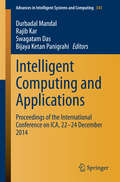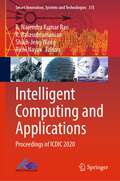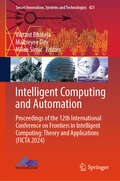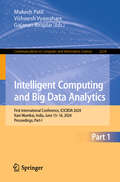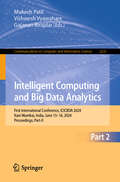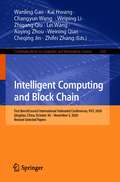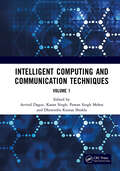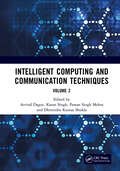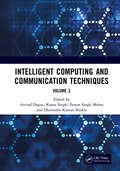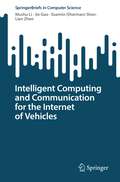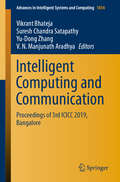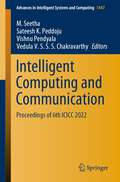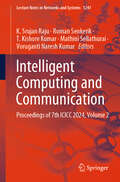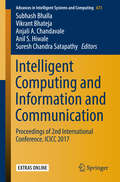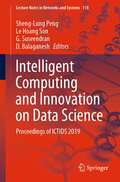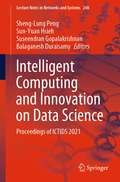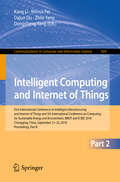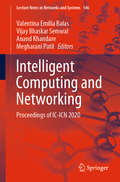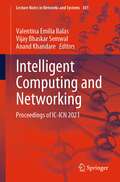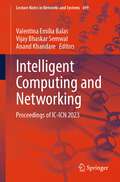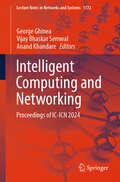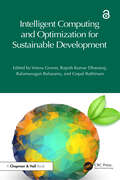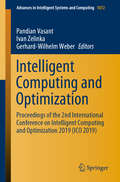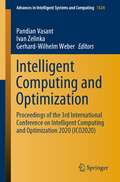- Table View
- List View
Intelligent Computing and Applications
by Bijaya Ketan Panigrahi Swagatam Das Durbadal Mandal Rajib KarThe idea of the 1st International Conference on Intelligent Computing and Applications (ICICA 2014) is to bring the Research Engineers, Scientists, Industrialists, Scholars and Students together from in and around the globe to present the on-going research activities and hence to encourage research interactions between universities and industries. The conference provides opportunities for the delegates to exchange new ideas, applications and experiences, to establish research relations and to find global partners for future collaboration. The proceedings covers latest progresses in the cutting-edge research on various research areas of Image, Language Processing, Computer Vision and Pattern Recognition, Machine Learning, Data Mining and Computational Life Sciences, Management of Data including Big Data and Analytics, Distributed and Mobile Systems including Grid and Cloud infrastructure, Information Security and Privacy, VLSI, Electronic Circuits, Power Systems, Antenna, Computational fluid dynamics & Heat transfer, Intelligent Manufacturing, Signal Processing, Intelligent Computing, Soft Computing, Bio-informatics, Bio Computing, Web Security, Privacy and E-Commerce, E-governance, Service Orient Architecture, Data Engineering, Open Systems, Optimization, Communications, Smart wireless and sensor Networks, Smart Antennae, Networking and Information security, Machine Learning, Mobile Computing and Applications, Industrial Automation and MES, Cloud Computing, Green IT, IT for Rural Engineering, Business Computing, Business Intelligence, ICT for Education for solving hard problems, and finally to create awareness about these domains to a wider audience of practitioners.
Intelligent Computing and Applications: Proceedings of ICDIC 2020 (Smart Innovation, Systems and Technologies #315)
by R. Balasubramanian Shiuh-Jeng Wang Richi Nayak B. Narendra Kumar RaoThis book presents novel work of academicians, researchers, industry professionals, practitioners, and budding engineers to disseminate the most recent innovations, trends, and concerns along with the present-day challenges and the solving approaches for implementation in the domains of data science, intelligent computing, and computer networks and security. It is a collection of selected high-quality research papers from the International Conference on Data Science, Intelligent Computing and Cyber Security (ICDIC 2020) organized by Sree Vidyanikethan Engineering College, Tirupati, India, during 27–29 February 2020. It discusses the latest challenges and solutions in the field of data innovation, data management, data analysis, data security, and intelligent methods and applications.
Intelligent Computing and Automation: Proceedings of the 12th International Conference on Frontiers in Intelligent Computing: Theory and Applications (FICTA 2024) (Smart Innovation, Systems and Technologies #421)
by Vikrant Bhateja Milan Simic Maitreyee DeyThe book presents the proceedings of the 12th International Conference on Frontiers of Intelligent Computing: Theory and Applications (FICTA 2024), held at Intelligent Systems Research Group (ISRG), London Metropolitan University, London, United Kingdom, during June 6–7, 2024. Researchers, scientists, engineers and practitioners exchange new ideas and experiences in the domain of intelligent computing theories with prospective applications in various engineering disciplines in the book. This book is divided into four volumes. It covers broad areas of information and decision sciences, with papers exploring both the theoretical and practical aspects of data-intensive computing, data mining, evolutionary computation, knowledge management and networks, sensor networks, signal processing, wireless networks, protocols and architectures. This book is a valuable resource for postgraduate students in various engineering disciplines.
Intelligent Computing and Big Data Analytics: First International Conference, ICICBDA 2024, Navi Mumbai, India, June 15–16, 2024, Proceedings, Part-I (Communications in Computer and Information Science #2234)
by Vishwesh Vyawahare Mukesh Patil Gajanan BirajdarThis book constitutes the refereed proceedings of the First International Conference on Intelligent Computing and Big Data Analytics, ICICBDA 2024, held in Navi Mumbai, India, during June 15–16, 2024. The 48 full papers presented were carefully reviewed and selected from 275 submissions. The accepted submissions report original and novel results in various fields like Intelligent Security systems, Big Data Analytics, AI and ML applications, intelligent systems, Deep Learning, Blockchain, and many more.
Intelligent Computing and Big Data Analytics: First International Conference, ICICBDA 2024, Navi Mumbai, India, June 15–16, 2024, Proceedings, Part-II (Communications in Computer and Information Science #2235)
by Vishwesh Vyawahare Mukesh Patil Gajanan BirajdarThis book constitutes the refereed proceedings of the First International Conference on Intelligent Computing and Big Data Analytics, ICICBDA 2024, held in Navi Mumbai, India, during June 15–16, 2024. The 48 full papers presented were carefully reviewed and selected from 275 submissions. The accepted submissions report original and novel results in various fields like Intelligent Security systems, Big Data Analytics, AI and ML applications, intelligent systems, Deep Learning, Blockchain, and many more.
Intelligent Computing and Block Chain: First BenchCouncil International Federated Conferences, FICC 2020, Qingdao, China, October 30 – November 3, 2020, Revised Selected Papers (Communications in Computer and Information Science #1385)
by Lei Wang Aoying Zhou Kai Hwang Wanling Gao Changyun Wang Weiping Li Zhigang Qiu Weining Qian Cheqing Jin Zhifei ZhangThis book constitutes the refereed post-conference proceedings of the Second BenchCouncil International Federated Intelligent Computing and Block Chain Conferences, FICC 2020, held in Qingdao, China, in October/ November 2020.The 32 full papers and 6 short papers presented were carefully reviewed and selected from 103 submissions. The papers of this volume are organized in topical sections on AI and medical technology; AI and big data; AI and block chain; AI and education technology; and AI and financial technology.
Intelligent Computing and Communication Techniques: Proceedings of the International Conference on Intelligent Computing and Communication Techniques (ICICCT 2024), New Delhi, India, 28-29 June, 2024 (Volume 1)
by Karan Singh Pawan Singh Mehra Arvind Dagur Dhirendra Kumar ShuklaThis book contains a prolific compilation of research papers presented at the International Conference on Intelligent Computing and Communication Techniques (ICICCT 2024). Some of its key features include: In-depth coverage of artificial intelligence, blockchain, and their role in enhancing smart living and security, with a focus on intelligent computing. Depiction of detailed system models and architecture to illustrate the practical applications of AI. Discussion on the role of AI and blockchain in banking, healthcare, navigation, communication, security, etc. Analysis of the challenges and opportunities presented by intelligent computing, communication techniques and blockchain in healthcare, education, banking and related industries. It is designed for academics, researchers, students, and professionals seeking to expand their knowledge and engage with current research on artificial intelligence, secure transactions, real-time monitoring, and security.
Intelligent Computing and Communication Techniques: Proceedings of the International Conference on Intelligent Computing and Communication Techniques (ICICCT 2024), New Delhi, India, 28-29 June, 2024 (Volume 2)
by Karan Singh Pawan Singh Mehra Arvind Dagur Dhirendra Kumar ShuklaThis book contains a prolific compilation of research papers presented at the International Conference on Intelligent Computing and Communication Techniques (ICICCT 2024). Some of its key features include: In-depth coverage of artificial intelligence, blockchain, and their role in enhancing smart living and security, with a focus on intelligent computing. Depiction of detailed system models and architecture to illustrate the practical applications of AI. Discussion on the role of AI and blockchain in banking, healthcare, navigation, communication, security, etc. Analysis of the challenges and opportunities presented by intelligent computing, communication techniques and blockchain in healthcare, education, banking and related industries. It is designed for academics, researchers, students, and professionals seeking to expand their knowledge and engage with current research on artificial intelligence, secure transactions, real-time monitoring, and security.
Intelligent Computing and Communication Techniques: Proceedings of the International Conference on Intelligent Computing and Communication Techniques (ICICCT 2024), New Delhi, India, 28-29 June, 2024 (Volume 3)
by Karan Singh Pawan Singh Mehra Arvind Dagur Dhirendra Kumar ShuklaThis book contains a prolific compilation of research papers presented at the International Conference on Intelligent Computing and Communication Techniques (ICICCT 2024). Some of its key features include: In-depth coverage of artificial intelligence, blockchain, and their role in enhancing smart living and security, with a focus on intelligent computing. Depiction of detailed system models and architecture to illustrate the practical applications of AI. Discussion on the role of AI and blockchain in banking, healthcare, navigation, communication, security, etc. Analysis of the challenges and opportunities presented by intelligent computing, communication techniques and blockchain in healthcare, education, banking and related industries. It is designed for academics, researchers, students, and professionals seeking to expand their knowledge and engage with current research on artificial intelligence, secure transactions, real-time monitoring, and security.
Intelligent Computing and Communication for the Internet of Vehicles (SpringerBriefs in Computer Science)
by Lian Zhao Jie Gao Xuemin (Sherman) Shen Mushu LiThis book investigates intelligent network resource management for IoV, with the objective of maximizing the communication and computing performance of vehicle users. Focusing on two representative use cases in IoV, i.e., safety message broadcast and autonomous driving, the authors propose link-layer protocol design and application-layer computing task scheduling to achieve the objective given the unique characteristics and requirements of IoV. In particular, this book illustrates the challenges of resource management for IoV due to network dynamics, such as time-varying traffic intensity and vehicle mobility, and presents intelligent resource management solutions to adapt to the network dynamics. The Internet of Vehicles (IoV) enables vehicle-to-everything connectivity and supports a variety of applications for vehicles on the road.Intelligent resource management is critical for satisfying demanding communication and computing requirements on IoV, while the highly dynamic network environments pose challenges to the design of resource management schemes. This book provides insights into the significance of adaptive resource management in improving the performance of IoV. The customized communication protocol and computing scheduling scheme are designed accordingly by taking the network dynamics information as an integral design factor. Moreover, the decentralized designs of the proposed solutions guarantee low signaling overhead and high scalability.A comprehensive literature review summarizing recent resource management schemes in IoV, followed by the customized design of communication and computing solutions for the two IoV use cases is included which can serve as a useful reference for professionals from both academia and industry in the area of IoV and resource management. Researchers working within this field and computer science and electrical engineering students will find this book useful as well.
Intelligent Computing and Communication: Proceedings of 3rd ICICC 2019, Bangalore (Advances in Intelligent Systems and Computing #1034)
by Suresh Chandra Satapathy Vikrant Bhateja V. N. Manjunath Aradhya Yu-Dong ZhangThis book features a collection of high-quality, peer-reviewed papers presented at the Third International Conference on Intelligent Computing and Communication (ICICC 2019) held at the School of Engineering, Dayananda Sagar University, Bengaluru, India, on 7 – 8 June 2019. Discussing advanced and multi-disciplinary research regarding the design of smart computing and informatics, it focuses on innovation paradigms in system knowledge, intelligence and sustainability that can be applied to provide practical solutions to a number of problems in society, the environment and industry. Further, the book also addresses the deployment of emerging computational and knowledge transfer approaches, optimizing solutions in various disciplines of science, technology and healthcare.
Intelligent Computing and Communication: Proceedings of 6th ICICC 2022 (Advances in Intelligent Systems and Computing #1447)
by Vishnu Pendyala Sateesh K. Peddoju M. Seetha Vedula V. S. S. S. ChakravarthyThis book features a collection of high-quality, peer-reviewed papers presented at the Sixth International Conference on Intelligent Computing and Communication (ICICC 2022) organized by Department of Computer Science and Engineering, G. Narayanamma Institute of Technology and Science (for women) Autonomous, Hyderabad, India, on November 18–19, 2022. It focuses on innovation paradigms in system knowledge, intelligence, and sustainability that can be applied to provide practical solutions to a number of problems in society, the environment, and industry. Further, the book also addresses the deployment of emerging computational and knowledge transfer approaches, optimizing solutions in various disciplines of science, technology, and healthcare.
Intelligent Computing and Communication: Proceedings of 7th ICICC 2024, Volume 2 (Lecture Notes in Networks and Systems #1241)
by Roman Senkerik K. Srujan Raju Mathini Sellathurai T. Kishore Kumar Voruganti Naresh KumarThis book features a collection of high-quality, peer-reviewed papers presented at the Seventh International Conference on Intelligent Computing and Communication (ICICC 2024) organized by CMR Technical Campus (CMRTC), Hyderabad, Telangana, India, on August 30–31, 2024. It focuses on innovation paradigms in system knowledge, intelligence, and sustainability that can be applied to provide practical solutions to several problems in society, the environment, and industry. Further, the book also addresses the deployment of emerging computational and knowledge transfer approaches, optimizing solutions in various disciplines of science, technology, and health care.
Intelligent Computing and Information and Communication
by Suresh Chandra Satapathy Vikrant Bhateja Subhash Bhalla Anjali A. Chandavale Anil S. HiwaleThe volume presents high quality research papers presented at Second International Conference on Information and Communication Technology for Intelligent Systems (ICICC 2017). The conference was held during 2-4 August 2017, Pune, India and organized communally by Dr. Vishwanath Karad MIT World Peace University, Pune, India at MIT College of Engineering, Pune and supported by All India Council for Technical Education (AICTE) and Council of Scientific and Industrial Research (CSIR). The volume contains research papers focused on ICT for intelligent computation, communications and audio, and video data processing.
Intelligent Computing and Innovation on Data Science: Proceedings of ICTIDS 2019 (Lecture Notes in Networks and Systems #118)
by Sheng-Lung Peng Le Hoang Son G. Suseendran D. BalaganeshThis book covers both basic and high-level concepts relating to the intelligent computing paradigm and data sciences in the context of distributed computing, big data, data sciences, high-performance computing and Internet of Things. It is becoming increasingly important to develop adaptive, intelligent computing-centric, energy-aware, secure and privacy-aware systems in high-performance computing and IoT applications. In this context, the book serves as a useful guide for industry practitioners, and also offers beginners a comprehensive introduction to basic and advanced areas of intelligent computing. Further, it provides a platform for researchers, engineers, academics and industrial professionals around the globe to showcase their recent research concerning recent trends. Presenting novel ideas and stimulating interesting discussions, the book appeals to researchers and practitioners working in the field of information technology and computer science.
Intelligent Computing and Innovation on Data Science: Proceedings of ICTIDS 2021 (Lecture Notes in Networks and Systems #248)
by Sheng-Lung Peng Suseendran Gopalakrishnan Sun-Yuan Hsieh Balaganesh DuraisamyThis book gathers high-quality papers presented at 2nd International Conference on Technology Innovation and Data Sciences (ICTIDS 2021), organized by Lincoln University, Malaysia from 19 – 20 February 2021. It covers wide range of recent technologies like artificial intelligence and machine learning, big data and data sciences, Internet of Things (IoT), and IoT-based digital ecosystem. The book brings together works from researchers, scientists, engineers, scholars and students in the areas of engineering and technology, and provides an opportunity for the dissemination of original research results, new ideas, research and development, practical experiments, which concentrate on both theory and practices, for the benefit of common man.
Intelligent Computing and Internet of Things: First International Conference On Intelligent Manufacturing And Internet Of Things And 5th International Conference On Computing For Sustainable Energy And Environment, Imiot And Icsee 2018, Chongqing, China, September 21-23, 2018, Proceedings, Part Ii (Communications In Computer And Information Science #924)
by Kang Li Dongsheng Yang Zhile Yang Minrui Fei Dajun DuThe three-volume set CCIS 923, CCIS 924, and CCIS 925 constitutes the thoroughly refereed proceedings of the First International Conference on Intelligent Manufacturing and Internet of Things, and of the 5th International Conference on Intelligent Computing for Sustainable Energy and Environment, ICSEE 2018, held in Chongqing, China, in September 2018. The 135 revised full papers presented were carefully reviewed and selected from over 385 submissions.The papers of this volume are organized in topical sections on: digital manufacturing; industrial product design; logistics, production and operation management; manufacturing material; manufacturing optimization; manufacturing process; mechanical transmission system; robotics.
Intelligent Computing and Networking: Proceedings of IC-ICN 2020 (Lecture Notes in Networks and Systems #146)
by Valentina Emilia Balas Vijay Bhaskar Semwal Anand Khandare Megharani PatilThis book gathers high-quality peer-reviewed research papers presented at the International Conference on Intelligent Computing and Networking (IC-ICN 2020), organized by the Computer Department, Thakur College of Engineering and Technology, in Mumbai, Maharashtra, India, on February 28–29, 2020. The book includes innovative and novel papers in the areas of intelligent computing, artificial intelligence, machine learning, deep learning, fuzzy logic, natural language processing, human–machine interaction, big data mining, data science and mining, applications of intelligent systems in healthcare, finance, agriculture and manufacturing, high-performance computing, computer networking, sensor and wireless networks, Internet of Things (IoT), software-defined networks, cryptography, mobile computing, digital forensics and blockchain technology.
Intelligent Computing and Networking: Proceedings of IC-ICN 2021 (Lecture Notes in Networks and Systems #301)
by Valentina Emilia Balas Vijay Bhaskar Semwal Anand KhandareThis book gathers high-quality peer-reviewed research papers presented at the International Conference on Intelligent Computing and Networking (IC-ICN 2021), organized by the Computer Department, Thakur College of Engineering and Technology, in Mumbai, Maharashtra, India, on February 26–27, 2021. The book includes innovative and novel papers in the areas of intelligent computing, artificial intelligence, machine learning, deep learning, fuzzy logic, natural language processing, human–machine interaction, big data mining, data science and mining, applications of intelligent systems in health ,care, finance, agriculture and manufacturing, high-performance computing, computer networking, sensor and wireless networks, Internet of Things (IoT), software-defined networks, cryptography, mobile computing, digital forensics, and blockchain technology.
Intelligent Computing and Networking: Proceedings of IC-ICN 2022 (Lecture Notes in Networks and Systems #632)
by Valentina Emilia Balas Vijay Bhaskar Semwal Anand KhandareThis book gathers high-quality peer-reviewed research papers presented at the International Conference on Intelligent Computing and Networking (IC-ICN 2022), organized by the Computer Department, Thakur College of Engineering and Technology, in Mumbai, Maharashtra, India, on February 25–26, 2022. The book includes innovative and novel papers in the areas of intelligent computing, artificial intelligence, machine learning, deep learning, fuzzy logic, natural language processing, human–machine interaction, big data mining, data science and mining, applications of intelligent systems in healthcare, finance, agriculture and manufacturing, high-performance computing, computer networking, sensor and wireless networks, Internet of Things (IoT), software-defined networks, cryptography, mobile computing, digital forensics and blockchain technology.
Intelligent Computing and Networking: Proceedings of IC-ICN 2023 (Lecture Notes in Networks and Systems #699)
by Valentina Emilia Balas Vijay Bhaskar Semwal Anand KhandareThis book gathers high-quality peer-reviewed research papers presented at the International Conference on Intelligent Computing and Networking (IC-ICN 2023), organized by the Computer Engineering Department, Thakur College of Engineering and Technology, in Mumbai, Maharashtra, India, on February 24–25, 2023. The book includes innovative and novel papers in the areas of intelligent computing, artificial intelligence, machine learning, deep learning, fuzzy logic, natural language processing, human–machine interaction, big data mining, data science and mining, applications of intelligent systems in healthcare, finance, agriculture and manufacturing, high-performance computing, computer networking, sensor and wireless networks, Internet of Things (IoT), software-defined networks, cryptography, mobile computing, digital forensics and blockchain technology.
Intelligent Computing and Networking: Proceedings of IC-ICN 2024 (Lecture Notes in Networks and Systems #1172)
by George Ghinea Vijay Bhaskar Semwal Anand KhandareThis book gathers high-quality peer-reviewed research papers presented at the International Conference on Intelligent Computing and Networking (IC-ICN 2024), organized by the Computer Department, Thakur College of Engineering and Technology, in Mumbai, Maharashtra, India, on February 23–24, 2024. The book includes innovative and novel papers in the areas of intelligent computing, artificial intelligence, machine learning, deep learning, fuzzy logic, natural language processing, human–machine interaction, big data mining, data science and mining, applications of intelligent systems in healthcare, finance, agriculture and manufacturing, high-performance computing, computer networking, sensor and wireless networks, Internet of Things (IoT), software-defined networks, cryptography, mobile computing, digital forensics, and blockchain technology.
Intelligent Computing and Optimization for Sustainable Development
by Balamurugan Balusamy Rajesh Kumar Dhanaraj Veena Grover Gopal RathinamThis book presents insights into how Intelligent Computing and Optimization techniques can be used to attain the goals of Sustainable Development. It provides a comprehensive overview of the latest breakthroughs and recent developments in sustainable, intelligent computing technologies, applications, and optimization techniques across various industries, including business process management, manufacturing, financial sector, agriculture, financial sector, supply chain management, and healthcare. It focuses on computational intelligent techniques and optimization techniques to provide sustainable solutions to many problems. Features: Provides insights into the theory, implementation, and application of computational intelligence techniques in many industries Includes industry practitioner perspectives and case studies for a better understanding of sustainable solutions Highlights the role of intelligent computing and optimization as key technologies in decision-making processes and in providing cutting-edge solutions to real-world problems Addresses the challenges and limitations of computational approaches in sustainability, such as data availability, model uncertainty, and computational complexity, while also discusses emerging opportunities and future directions in the field This book will be useful for professionals and scholars looking for up-to-date research on cutting-edge perspectives in the field of computational intelligent and optimization techniques in the areas of agriculture, industry, financial sector, business automation, renewable energy, optimization, and smart cities.
Intelligent Computing and Optimization: Proceedings of the 2nd International Conference on Intelligent Computing and Optimization 2019 (ICO 2019) (Advances in Intelligent Systems and Computing #1072)
by Pandian Vasant Ivan Zelinka Gerhard-Wilhelm WeberThis book presents the outcomes of the second edition of the International Conference on Intelligent Computing and Optimization (ICO) – ICO 2019, which took place on October 3–4, 2019, in Koh Samui, Thailand. Bringing together research scholars, experts, and investigators from around the globe, the conference provided a platform to share novel research findings, recent advances and innovative applications in the field. Discussing the need for smart disciplinary processes embedded into interdisciplinary collaborations in the context of meeting the growing global populations’ requirements, such as food and health care, the book highlights the role of intelligent computation and optimization as key technologies in decision-making processes and in providing cutting edge solutions to real-world problems.
Intelligent Computing and Optimization: Proceedings of the 3rd International Conference on Intelligent Computing and Optimization 2020 (ICO 2020) (Advances in Intelligent Systems and Computing #1324)
by Pandian Vasant Ivan Zelinka Gerhard-Wilhelm WeberThird edition of International Conference on Intelligent Computing and Optimization and as a premium fruit, this book, pursue to gather research leaders, experts and scientists on Intelligent Computing and Optimization to share knowledge, experience and current research achievements. Conference and book provide a unique opportunity for the global community to interact and share novel research results, explorations and innovations among colleagues and friends. This book is published by SPRINGER, Advances in Intelligent Systems and Computing. Ca. 100 authors submitted full papers to ICO’2020. That global representation demonstrates the growing interest of the research community here. The book covers innovative and creative research on sustainability, smart cities, meta-heuristics optimization, cyber-security, block chain, big data analytics, IoTs, renewable energy, artificial intelligence, Industry 4.0, modeling and simulation. We editors thank all authors and reviewers for their important service. Best high-quality papers have been selected by the International PC for our premium series with SPRINGER.
